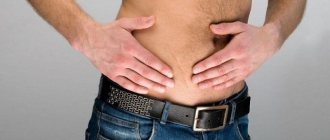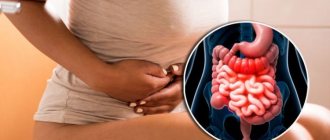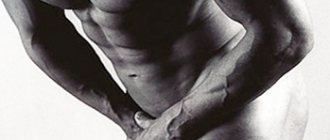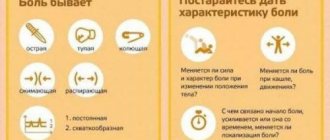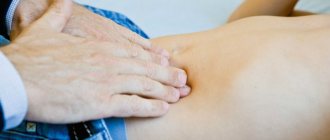- Causes of pain
- Diagnostics
- Possible diseases
- Treatment
- Our doctors
The right side of the abdomen contains several vital organs. The development of pathology in one of them provokes characteristic pain. Knowing the causes of this condition is necessary for timely consultation with a doctor and will help avoid serious complications.
Most often, women are bothered by pain in the lower abdomen. But in some cases this symptom manifests itself in men. Knowing the possible causes, you can immediately consult a doctor for help if you suspect a pathology. This will avoid complications and significantly speed up recovery.
Causes of pain
Typically, pain in the lower abdomen in men is associated with urological problems. But it also appears when other organs are affected:
- gastrointestinal tract;
- excretory system;
- musculoskeletal system.
The appearance of unpleasant sensations in the lower abdomen in men is due to a pathological process, because normally there is no pain. It can be of different types:
- inflammation;
- infection;
- ulceration;
- fluid accumulation;
- weakness of the ligamentous apparatus.
There are many reasons why a man’s lower abdomen hurts. To make an accurate diagnosis, a comprehensive examination of the patient is necessary.
Diseases of the musculoskeletal system
ARS syndrome is inflammation and degeneration of tendons and ligaments attached to the pubic bone and symphysis. Athletes face this. Pain is observed in the lower abdomen and groin area, intensifying with hip abduction.
Hip sprain. May be caused by a fall or sudden abduction of the hip while performing any exercise.
Coxarthrosis, arthropathy, femoral neck fracture. These are diseases associated with damage or disease to the hip joint and the proximal part of the femur where it attaches to the joint.
Diagnostics
The examination of the patient begins with examination, collection of complaints and anamnesis, and palpation. Based on the results, the doctor makes a preliminary diagnosis, which is clarified by additional diagnostic methods:
- general blood test - will indicate the presence of inflammation and infection;
- a general urine test will detect kidney damage;
- Ultrasound - will show changes in tissue and size of internal organs;
- Prostate fluid test will detect problems with the prostate.
A complete and correct diagnosis is half the success in treating the disease. Therefore, you need to contact only trusted medical institutions with qualified doctors.
Why is it important to see a doctor?
There are many causes of groin pain, and the nature of the symptom can only be determined after a thorough diagnosis.
Self-medication can make the problem worse, so it is important to see a doctor as soon as possible. The State Urology Center provides qualified medical care under the compulsory medical insurance policy, so the procedures and treatment prescribed by the doctor will be free for you. First, sign up for a consultation with a specialist, then we can relieve you of unpleasant symptoms and restore your health. April 19, 2021
Hakobyan Gagik Nersesovich - urologist, oncologist, MD, doctor of the highest category, professor
All the symptoms of the disease...
Possible diseases
When a man has pain in the lower abdomen, several diseases can be suspected at once. Main diagnoses:
- cystitis, urethritis;
- prostatitis;
- vesiculitis;
- BPH;
- urolithiasis disease;
- diverticulitis;
- testicular cysts;
- peptic ulcer;
- pyelonephritis;
- oncology;
- orchitis and orchiepididymitis;
- varicocele;
- appendicitis;
- inguinal hernia and its strangulation;
- duodenitis.
The list of diseases that cause pain in a man’s lower abdomen is quite long. Only a doctor can correctly diagnose and prescribe treatment. And the patient’s life sometimes depends on well-chosen therapy.
Causes of abdominal pain
Cramping abdominal pain (colic)
caused by irritation of the nerve receptors on the inner surface of the hollow organs. In this case, a spasm of smooth muscles occurs - the muscle tissue lining the corresponding organ. Such pains are usually very strong, painful, but do not last long - a few minutes, after which they pass. Attacks can follow one after another, the pain first increases, then decreases...
Attacks can be caused by the movement of stones (in the kidneys, in the gallbladder or duct, in the ureters), inflammatory diseases, and poisoning. One of the common reasons is a violation of the diet (too spicy, salty, fatty foods, excessive eating).
Attacks of pain can be combined with other symptoms - fever, chills (typical of infections and blockage of the bile ducts), changes in the color of urine and stool (with blockage of the bile ducts, the urine darkens and the stool becomes lighter).
Pain can be caused by stretching of hollow organs or tension of their ligaments
(for example, due to injury). It is usually aching or pulling and may not have a clear localization.
Pain may be caused by impaired local circulation
(congestion in the vessels of the abdominal cavity), the so-called “abdominal toad” is an attack of pain at the moment of greatest functional activity of the digestive organs.
Acute pain occurs with pathological structural changes or damage to internal organs
- inflammation, tumor growth, ulceration, rupture (perforation), transition of the inflammatory process to the peritoneal tissue (peritonitis).
Pain in the abdominal area is not always associated with diseases of the organs located there. Referred pain is quite common
. In this case, they say that the pain radiates: its source is elsewhere, but the patient feels pain in the abdominal area. This is possible with pneumonia, heart disease, pleurisy, diseases of the esophagus and in some other cases.
Abdominal pain may also have a psychogenic origin
. Stress, emotional tension, and fear can lead to pain, in some cases quite severe.
Treatment
Based on the diagnosis, the doctor develops a treatment plan. It may include several groups of medications:
- antibiotics;
- anti-inflammatory;
- enveloping (for peptic ulcer);
- chemotherapy.
In some cases, conservative therapy is powerless. Then the patient is indicated for surgical intervention. In order for it to pass without complications, you need to carefully choose a doctor and a clinic for treatment.
Pain in the lower abdomen in men is no less dangerous than in women. They can be a signal of the development of a tumor process or an inflammatory disease. A timely and correct diagnosis is half the success of treatment. Therefore, it is important to find a good clinic for examination and trust your doctor. Then it will be possible to quickly recover, avoid complications, and in some cases save the patient’s life.
Read also: Pain in left side
Dear patients! Remember that only a qualified doctor can make an accurate diagnosis, determine the causes and nature of the disease, and prescribe effective treatment. You can make an appointment with our specialists or call a doctor at home by calling 8-(4822)-33-00-33
Be healthy and happy!
Generalized pain
In this case, the patient complains of discomfort throughout the abdomen. The syndrome can be caused by the following conditions.
- Constipation. The situation is accompanied by bloating, loss of appetite, and sometimes nausea. The solution to the problem is drinking plenty of fluids and eating foods rich in fiber.
- Irritable bowel syndrome. The condition is characterized by colicky pain, accompanied by diarrhea or constipation, and bloating. Therapy is focused on eliminating the causes of the disease and includes diet.
- Back pain can radiate to the abdomen, which indicates disorders in the lumbosacral spine and requires consultation with a neurologist.
Bowel diseases
Intestinal function is negatively affected by a passive lifestyle, unbalanced diet, drinking alcohol, smoking, and stress. If the intestines are disrupted, heaviness and bloating are felt in the abdomen, diarrhea begins (defecation from 3 to 20 times per day) or, conversely, constipation (the intestines do not empty for more than three days).
With intestinal dysfunction, the pain is nagging, caused by contraction of smooth muscles.
Pain in the right side in men may occur due to inflammation of the appendix, which is an appendage of the cecum and is located between the ilium and the navel. The pathology provokes acute pain, nausea, vomiting, and fever. At first the whole stomach hurts, but after two hours the pain intensifies and is felt in the right side at the very bottom.
The appendix may be located atypically, so pain in the pubic area or lower back is likely
The right side hurts severely and as a result of inflammation of the small intestine (ileitis). Pathology develops due to the activity of pathogenic microorganisms. It is characterized by pain in the side, flatulence, vomiting, nausea, and diarrhea. If the disease becomes chronic, the mucous tissue of the small intestine gradually atrophies.
In Crohn's disease, inflammation can develop in any part of the digestive tract. If the lesion affects the large intestine, then the person feels severe discomfort in the right iliac region, nausea, fever, in addition, vomiting, diarrhea occurs, and weight decreases sharply.
What pain does appendicitis cause?
Ulcerative colitis results in intense, sharp pain on the lower left or right side, depending on where the inflammation is located in the colon.
If there are painful abdominal cramps, belching, constipation, vomiting, then this is probably due to intestinal obstruction. It occurs because motor skills are impaired, as a result of which accumulated food is not evacuated. The pain increases over the course of two days and is characterized as bursting and acute.
As a result of heavy lifting or prolonged tension of the abdominal muscles, a hernia can occur, which can also cause pain in the right lower side. The hernia is most often found in the inguinal canal, where the spermatic cord is located. If its size is significant, then the protrusion can be seen when examining the groin area.
If the hernia is small, it is not visible, but it causes nagging pain in the right side of the lower abdomen (especially during physical activity, coughing or sneezing) and swelling of the scrotum. An inguinal hernia is surgically removed. When a hernia is strangulated (the clinical picture is supplemented by redness of the skin around the protrusion, fever, acute pain with burning when urinating or defecating), peritonitis may begin, which can lead to blood poisoning and death.
Pain in the area of the stomach and intestines can be caused by infectious diseases (botulism, tetanus, salmonellosis, cholera, dysentery) or helminthic infestation.
You can become infected with intestinal infections by consuming contaminated water or food if personal hygiene rules are not followed.
If the intestinal tumor is located on the right side, then it provokes moderate nagging or cramping pain in the right side of the abdomen. At first, the formation of the disease does not provoke painful sensations, but as it develops, neighboring tissues are affected. With colorectal cancer, constipation, bleeding from the anus, pain during bowel movements appear, weight loss and a constant increase in basal temperature are also observed.
Gallbladder dysfunction
When the functioning of the gallbladder and its ducts changes, a sharp pain is felt in the upper right part of the abdomen. As smooth muscle tone occurs, sensations migrate to the back, under the left shoulder blade, to the heart area.
Gallbladder pathologies leading to pain in the right side:
- cholecystitis (inflammation of the bladder). With pathology, digestion is disrupted because not enough bile enters the duodenum;
- cholelithiasis. The release of the stone from the bladder leads to severe paroxysmal pain. Pain appears between the right hypochondrium and the epigastrium, it migrates to the shoulder;
- Cholangitis (inflammation of the ducts) develops as a result of blockage of the ducts. The pain appears cramping and is localized in the area of the right hypochondrium or epigastrium.
If there are no stones in the bladder, then the sensations are moderate
Liver pathology
If the lower abdomen on the right side hurts moderately, this may indicate pathologies occurring in the liver. The organ does not have nerve endings, therefore it itself does not hurt. As a result of inflammation, the size of the liver increases, and it begins to put pressure on neighboring organs, which leads to pain in the right side.
Deterioration in function is indicated by yellowing of the sclera and skin, indigestion, low-grade fever, and changes in the color of feces and urine. If there is an abscess, then sweating increases and muscle discomfort appears.
About pain after urination
Pain after urination usually indicates problems, diseases, pathologies that are present in the bladder. Most often, pain after urination is caused by inflammatory bacterial diseases, such as cystitis, chlamydia, pyelonephritis , etc.
Most often, women suffer from pain after urination, this is due to the structure of their body. The bladder is much closer and the urethra is much shorter than in a man, this helps infections reach the bladder much faster. Also, women are much more likely to experience hormonal changes, which also activate inflammatory infectious processes in the body.
Pain after urination may appear after hypothermia or failure to comply with personal hygiene rules, with untreated infections and diseases, with gynecological or venereological diseases of the genitourinary system. Pain after urination is a symptom of another serious illness that needs urgent treatment . Ignoring this issue entails serious problems that are fraught with deterioration of the body’s condition and the activation of new serious diseases.
Does your lower abdomen hurt? How to treat?
Treatment of urological problems is a long and scrupulous process. In most cases, only a set of measures can help.
We use methods such as:
- drug treatment;
- physical therapy;
- prostate massage;
- treatment with active oxygen (ozone therapy);
- mud therapy (Dead Sea mud);
- medical and medicinal droppers;
- adjusting the patient’s lifestyle and nutrition;
- development of an individual prevention program;
- monitoring the patient's condition after treatment.
